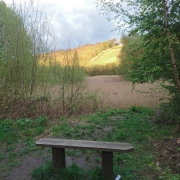Mindfulness meditation for novices-Part 3 ‘The mindfulness muscle’-it needs to be exercised!
I have been committed to mindfulness for a while. I love mindfulness, its simplicity, its obvious common sense and the fact it challenges the divergence of science and spirituality. I have an insight into its works at a physiological level and a belief in its value to all. My bookcase is beginning to fill. My enthusiasm for spreading the word continues to grow. And yet over a 3 week period my formal practice stopped, I no longer found 15 minutes to meditate each day.
Mindfulness is simple yet hard to do.
The Consequences of Not Exercising the Mindfulness Muscle
I have excuses I can share, but the truth is I had prioritised other things over meditating. I still carried out activities that were mindful but not necessarily with mindfulness being the intention.
In hindsight I can see that over those few weeks my emotions gained power at the expense of being in the world. I was not settled to work. I had forgotten things and not focused on the things that make me happy. I had become less able to be content. I returned to a state of frustration: frustrated with politics, poverty, the media and people. But I hadn’t seen it happening. I had slipped into old habits. I had kidded myself that by knowing the usefulness of being present in the moment, and by noticing thoughts, this was enough.
It was a simple statement from a friend which triggered a ‘non-mindful’ response, which made me feel the past was repeating on me, that I was forever in a cycle of failure, that I had no control, I was quickly pulled into the past which nearly became reality. The emotions this evoked brought back their own memories which were painful, and it hit home; I had allowed one simple statement power over the present moment. My ‘mindfulness muscle’ had grown weak through lack of exercise and was no longer able to keep me in the now, the past had hooked me in. My mindfulness muscle had lost its strength, my judgements had led to emotional overload and I was on the way to disaster. I was tearful, irrational and had catastrophized the situation.
The Importance of Regular Exercise
It was in the late 1990’s that I went for my first run. I managed a couple of minutes. I completed my first triathlon in 2002. I was enjoying exercising 5-6 times a week. It was sustainable, and I was fit and healthy. In 2009 I had a very rare leukaemia (acute promyelocytic leukaemia, APML). I tried exercising in hospital but had no will power or energy, and my routine slowly vanished. I ended up not exercising for 6 months. I have not run more than 3 km since despite being totally fit and healthy, I swim and do spinning classes every week. My running muscles have not been exercised and I no longer call myself a runner. I have run about 6 times since 2009, my muscles know what to do but have no stamina for running. Yet I am fit.
The Mindfulness Muscle
My experience with mindfulness has been the same. It improves with exercising, some days go well, some days don’t but the muscles have been worked. They have been used and not allowed to degenerate. Sometimes exercising can feel hard work but 99% of the time the value is experienced immediately. It is important to exercise the appropriate muscles to develop the specific skill. I had half believed reading about mindfulness would make me mindful, it improves knowledge, motivation, understanding but reading does not specifically stimulate the neurological changes that meditation does. Mindfulness is not only about meditating; exercising the brain, other ‘flow activities’ provide peace for the brain; where thoughts are not judged, and attention is given to current experience. The comparison continues with exercise, all exercise will impact on fitness, but you cannot improve an individual muscle without using it.
I have noticed several articles that describe practicing mindfulness as like exercising a muscle. I had no appreciation of how true that was until now. Knowing the theory, understanding the principles and acknowledging its efficacy seem to be no substitute for putting in the practice on a daily basis. Building up the new neurological pathways and dismantling the old ones is a continual process. Many of you interested in building muscle will have heard the saying ‘if you don’t use it you’ll lose it’ thus is true for Mindfulness too.
What Exercises Can Be Done?
Flow activities
Formal meditation seems to be the key, and a near daily habit is important but this can vary from a few minutes to a lot longer. I am getting a sense that trying to have a regular meditation of 20 minutes is optimum. I continue to enjoy the Headspace app., but there are others
The ways to be mindful are endless. The key is doing something with full awareness in the present. These might be referred to as ‘flow activities’. Adult colouring has become a trend, but anything that absorbs your attention works. This can be as mundane as washing up or as productive as writing a blog! My understanding is that flow activities focus your attention in the present, whilst letting go of expectations or rules for how things should be.
The Mindfulness Project have written ‘I am here now’- A creative guide and Journal’ offering exercises and ways to think positively to notice and enjoy the present moment.
The subtleties of the mindfulness muscle continue to amaze me. Since restarting meditation, it took only 4 days to notice a change in my attitude to work and relationships. I hope your mindfulness journey is going well, and you can overcome the blips.
You may also be interested in:
Mindfulness meditation for Novices: Sharing personal Experience- Part 1
Mindfulness meditation for Novices: Sharing personal experience- Part 2
Thoughts and Anxiety-Using Psychotherapy and Mindfulness to alleviate fretful thinking










